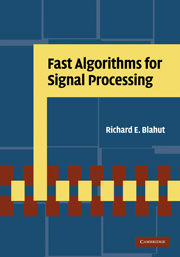Book contents
- Frontmatter
- Contents
- Preface
- Acknowledgments
- 1 Introduction
- 2 Introduction to abstract algebra
- 3 Fast algorithms for the discrete Fourier transform
- 4 Fast algorithms based on doubling strategies
- 5 Fast algorithms for short convolutions
- 6 Architecture of filters and transforms
- 7 Fast algorithms for solving Toeplitz systems
- 8 Fast algorithms for trellis search
- 9 Numbers and fields
- 10 Computation in finite fields and rings
- 11 Fast algorithms and multidimensional convolutions
- 12 Fast algorithms and multidimensional transforms
- A A collection of cyclic convolution algorithms
- B A collection of Winograd small FFT algorithms
- Bibliography
- Index
2 - Introduction to abstract algebra
Published online by Cambridge University Press: 03 May 2011
- Frontmatter
- Contents
- Preface
- Acknowledgments
- 1 Introduction
- 2 Introduction to abstract algebra
- 3 Fast algorithms for the discrete Fourier transform
- 4 Fast algorithms based on doubling strategies
- 5 Fast algorithms for short convolutions
- 6 Architecture of filters and transforms
- 7 Fast algorithms for solving Toeplitz systems
- 8 Fast algorithms for trellis search
- 9 Numbers and fields
- 10 Computation in finite fields and rings
- 11 Fast algorithms and multidimensional convolutions
- 12 Fast algorithms and multidimensional transforms
- A A collection of cyclic convolution algorithms
- B A collection of Winograd small FFT algorithms
- Bibliography
- Index
Summary
Good algorithms are elegant algebraic identities. To construct these algorithms, we must be familiar with the powerful structures of number theory and of modern algebra. The structures of the set of integers, of polynomial rings, and of Galois fields will play an important role in the design of signal-processing algorithms. This chapter will introduce those mathematical topics of algebra that will be important for later developments but that are not always known to students of signal processing. We will first study the mathematical structures of groups, rings, and fields. We shall see that a discrete Fourier transform can be defined in many fields, though it is most familiar in the complex field. Next, we will discuss the familiar topics of matrix algebra and vector spaces. We shall see that these can be defined satisfactorily in any field. Finally, we will study the integer ring and polynomial rings, with particular attention to the euclidean algorithm and the Chinese remainder theorem in each ring.
Groups
A group is a mathematical abstraction of an algebraic structure that appears frequently in many concrete forms. The abstract idea is introduced because it is easier to study all mathematical systems with a common structure at once, rather than to study them one by one.
Definition 2.1.1A group G is a set together with an operation (denoted by ✻) satisfying four properties.
- Type
- Chapter
- Information
- Fast Algorithms for Signal Processing , pp. 21 - 67Publisher: Cambridge University PressPrint publication year: 2010



